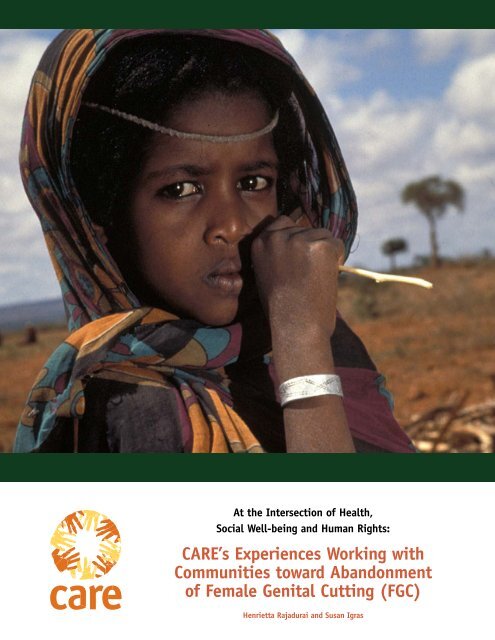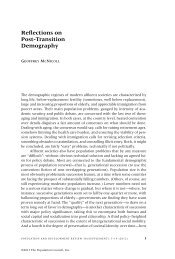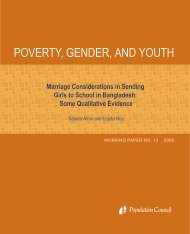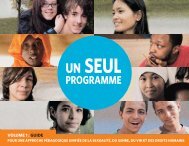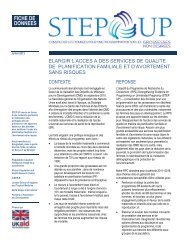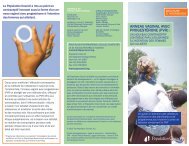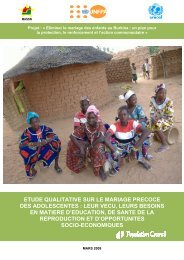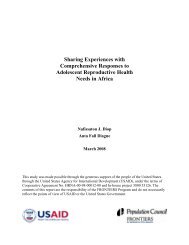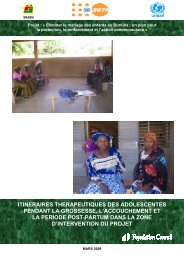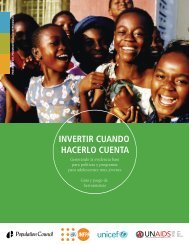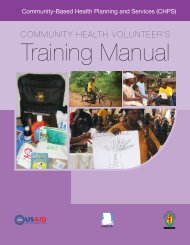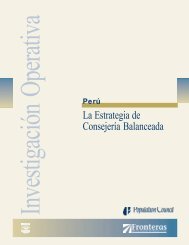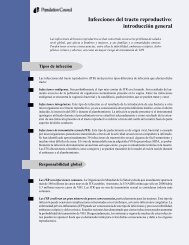CARE's Experiences Working with Communities toward ...
CARE's Experiences Working with Communities toward ...
CARE's Experiences Working with Communities toward ...
You also want an ePaper? Increase the reach of your titles
YUMPU automatically turns print PDFs into web optimized ePapers that Google loves.
At the Intersection of Health,<br />
Social Well-being and Human Rights:<br />
CARE’s <strong>Experiences</strong> <strong>Working</strong> <strong>with</strong><br />
<strong>Communities</strong> <strong>toward</strong> Abandonment<br />
of Female Genital Cutting (FGC)<br />
Henrietta Rajadurai and Susan Igras
INTRODUCTION 1<br />
Why FGC Abandonment is Such a Challenging Program Issue 1<br />
Why CARE Got Involved 2<br />
<strong>Working</strong> in Partnerships to Achieve Change 2<br />
PROJECT OVERVIEW 2<br />
Goals and Objectives 2<br />
Description of Project Sites 3<br />
Moving from Needs to Rights-Based Project Approaches: Necessary Changes 4<br />
Measuring Effectiveness of Community-Based Education and Advocacy Models: Research 6<br />
PREPARING TO BEGIN 6<br />
HIGHLIGHTS OF PROJECT ACTIVITIES 7<br />
Understanding the Context of the Practice through Discussion and Dialogue 7<br />
What We Learned: Some Critical Findings 9<br />
Education and Advocacy Activities 12<br />
Supporting Individual and Collective Actions for Change 16<br />
A Social Change Model: Guiding Education, Advocacy and Support of Early Adaptors 18<br />
RESEARCH RESULTS: SUCCESS OF THE INTEGRATED MODEL 19<br />
CONCLUSIONS AND SOME LESSONS LEARNED 20<br />
ACKNOWLEDGMENTS:<br />
The projects represented in this report were supported by the CARE USA Africa Fund and the Office of Population and<br />
Reproductive Health, Bureau of Global Health, U.S. Agency for International Development, under the terms of Cooperative<br />
Agreement No. HRN: A-00-98-00023-00. This publication was made possible by individual donors of CARE.<br />
Conceptualization and operationalization of the project was led by a small team of CARE staff and a consultant, including: Saida<br />
Ali, Susan Igras, Jacinta Muteshi, Da'ak Salah and Asmelash Wolde Mariam. Primary research assistance was provided by the<br />
Population Council Frontiers in Reproductive Health Project (Jane Chege and Ian Askew). Finally, it is the work of many<br />
unnamed project staff, and community volunteers and advocates that created and sustained the sparks of discussion and debate<br />
in a variety of communities in Ethiopia, Kenya and Sudan, which helped lead to the many results described in this document.<br />
Editing and support: Catherine Goolsby<br />
Design layout: Kim Conger<br />
This report makes extensive use of content and language from the three publications below as well as a variety of unpublished<br />
reports available from CARE.<br />
Chege, Jane, I Askew, S Igras, and J Muteshi. Testing the Effectiveness of Integrating Community-based Approaches for Encouraging<br />
Abandonment of Female Genital Cutting into CARE’s Reproductive Health Programs in Ethiopia and Kenya, Population Council.<br />
Frontiers in Reproductive Health Project. December 2004. http://www.popcouncil.org/pdfs/frontiers/FR_FinalReports/CARE_FGC.pdf<br />
Figueroa, Maria Elena, D Kincaid, M Rani, and G Lewis. Communication for Social Change: An Integrated Model for Measuring<br />
the Process and Its Outcomes. Rockefeller Foundation. Communication Initiative. 2002.<br />
Igras, Susan, J Muteshi, A WoldeMariam, and S Ali. Integrating Rights-Based Approaches into Community-Based Health<br />
Projects: <strong>Experiences</strong> from the Prevention of Female Genital Cutting Project in East Africa. Journal of Health and Human Rights<br />
Vol 7 (2): 251-271.2005.
INTRODUCTION<br />
Why FGC Abandonment is Such<br />
a Challenging Program Issue<br />
Female genital cutting (FGC) affects more<br />
than 130 million women and girls worldwide, the<br />
majority of whom live on the African continent.<br />
The term FGC refers to not one, but four differing<br />
forms of cutting, <strong>with</strong> infibulation being the<br />
most severe. Practiced for hundreds of years, the<br />
ritual of infibulation involves the excision of<br />
part or all of the external genitalia, <strong>with</strong> only a<br />
very small opening left for urine and menstrual<br />
blood. The burden of FGC cannot be laid on the<br />
shoulders of any one particular country or religion,<br />
as it is performed in a variety of social and cultural<br />
contexts and is essentially a practice frequently<br />
associated <strong>with</strong> distinct ethnic groups.<br />
For proponents of the practice, FGC represents<br />
a thread in the social fabric that defines the<br />
individual’s social standing and, ultimately, the<br />
community’s identity. The wide array of favorable<br />
motivations for the practice of FGC range from:<br />
respect for and conformity to culture and<br />
tradition; religious obligation; rite of passage into<br />
womanhood; ensuring a girl’s virginity and,<br />
consequently, her value and that of her family, and<br />
the increased likelihood of good marriage<br />
prospects. Underpinning these factors is another<br />
layer of reasons associated <strong>with</strong> gender roles and<br />
expressions of men and women’s sexuality.<br />
Yet this culturally sanctioned, traditional<br />
practice frequently carries <strong>with</strong> it many<br />
detrimental health and social consequences that<br />
persist throughout a woman’s life. Health<br />
complications of infibulation can include chronic<br />
and severe pain, infection, prolonged and difficult<br />
labor, malodorous urine retention and difficulties<br />
<strong>with</strong> menstruation. Psychologically, cutting can<br />
result in discord between couples due to painful or<br />
difficult sexual relations. From a social perspective,<br />
cutting can reduce potential education and<br />
income opportunities for girls by making them<br />
more vulnerable to early marriage. Considered from<br />
a human rights standpoint, FGC encroaches on a<br />
number of basic human rights, compromising<br />
women’s and girls’ rights to good health, to have<br />
economic independence and educational opportunities,<br />
and to attain higher standards of living.<br />
The absence of consent associated <strong>with</strong> the<br />
practice is indicative of a fundamental lack of<br />
respect for the rights of females and children.<br />
Girls who refuse the procedure, but still reside in<br />
communities embracing the tradition, face a<br />
diminished quality of life. For these girls and their<br />
immediate families, noncompliance incurs<br />
harassment and possible ostracism from their<br />
communities.<br />
|<br />
1
|<br />
2<br />
Why CARE Got Involved<br />
Discussions during a 1998 regional health<br />
meeting for CARE staff working in East and North<br />
Africa created the momentum for CARE to begin<br />
the pilot work in the area of FGC abandonment.<br />
FGC was presented as a harmful traditional<br />
practice having a negative impact on maternal<br />
and neonatal health. Through participatory<br />
learning and action (PLA) techniques, CARE staff<br />
and local women explored the issue of<br />
reproductive health (RH) in several countries.<br />
The women themselves recognized FGC as an<br />
important, sometimes the most important,<br />
health issue they faced. At that time CARE was<br />
in the process of shifting the focus of its<br />
RH programs, which had previously been<br />
predominantly based on addressing needs, to<br />
also address underlying social, gender and rights<br />
factors that influenced health outcomes. With<br />
the realization that CARE had a presence in 15<br />
countries where FGC was practiced, an extraordinary<br />
possibility surfaced for a multi-country FGC<br />
abandonment pilot project and related study.<br />
The project would allow CARE to gain<br />
experience and assess the effectiveness of<br />
rights-based approaches (RBA) when applied in a<br />
health context, and contribute to the growing<br />
body of FGC literature that could help advise the<br />
design of future FGC abandonment programs at<br />
the community level. It is CARE’s belief that<br />
using a basic human rights framework when<br />
working <strong>with</strong> communities would more effectively<br />
address the matrix of underlying causes of<br />
poverty and poor health. In turn, people would<br />
be empowered to take action for sustainable<br />
improvements in their lives. CARE staff in<br />
Ethiopia, Kenya and Sudan, working collaboratively<br />
<strong>with</strong> the health unit staff at CARE USA<br />
headquarters in Atlanta, developed a pilot<br />
project focusing on integrating activities that<br />
would lead to the abandonment of FGC <strong>with</strong>in<br />
community-based health projects.<br />
<strong>Working</strong> in Partnerships<br />
to Achieve Change<br />
The FGC abandonment project was realized<br />
<strong>with</strong> the help of several international and local<br />
partners including PATH (assisting <strong>with</strong> development<br />
of behavior change communication [BCC]<br />
messages) and the Population Council Frontiers<br />
in Reproductive Health Project (primary provider<br />
of technical assistance in research). At national<br />
and local levels, partners included Sudan’s<br />
National Committee Against Harmful Traditional<br />
Practices and the Sudanese and Ethiopian<br />
MOH/Social & Women’s Affairs. In Kenya, partners<br />
included the National Council of Churches,<br />
Médecins sans Frontières and UNHCR. Financial<br />
support was provided by the CARE USA Africa<br />
Fund, private CARE donors and the USAID<br />
Special Initiatives Fund from the Office of<br />
Population/RH.<br />
PROJECT OVERVIEW<br />
Goals and Objectives<br />
Past health programs in a variety of countries<br />
and settings attempted to eliminate FGC by<br />
focusing largely on the serious health effects that<br />
stemmed from the procedure, while neglecting the<br />
underlying social currents that governed the<br />
perpetuation of the practice. Consequently, these<br />
programs were only marginally successful at<br />
reducing FGC and often were met <strong>with</strong> strong<br />
resistance from communities. Drawing from past<br />
experiences, CARE understood that in order to<br />
motivate a community to consider abandoning a
deeply ingrained and culturally sanctioned practice<br />
such as FGC, interventions would have to extend<br />
beyond the realm of traditional community-level<br />
health programming. The scope would have to be<br />
expanded to address the social norms, beliefs and<br />
attitudes of the communities as a whole, as well as<br />
those of the individuals who reinforced the<br />
continuation of the practice.<br />
The goal of the FGC abandonment project was<br />
to improve the health and social well-being of<br />
young girls and women in the project areas by<br />
initially decreasing and eventually eliminating the<br />
practice of FGC, and so, two core project objectives<br />
were identified. First, CARE hoped to increase the<br />
interest and ability of communities, nongovernmental<br />
organizations (NGOs), ministries of health<br />
and other local actors to appropriately and<br />
effectively address FGC issues. Simultaneously,<br />
through its research component, CARE hoped to<br />
contribute to the body of evidence on the<br />
effectiveness of different community-based interventions<br />
aimed at reducing the practice of FGC.<br />
Description of Project Sites<br />
The multi-country FGC abandonment<br />
project operated in three countries where CARE<br />
already managed community-based health<br />
projects and where staff were interested in<br />
integrating FGC abandonment activities into<br />
their ongoing health projects. The projects<br />
reached the Afar people in Ethiopia, Somalis in<br />
the Dadaab refugee camps in Kenya and the<br />
Arabic Dar Hamid people in Sudan. Although<br />
ethnically diverse, these communities shared<br />
three defining links: a common religion (Islam),<br />
belief of an association between FGC and Islam<br />
and an almost universal practice of infibulation.<br />
Ethiopia<br />
In Ethiopia, CARE piloted FGC abandonment<br />
activities in the Afar region, which baseline<br />
surveys indicated had the highest rate of FGC in<br />
Ethiopia, 94.9 percent compared to a country wide<br />
rate of 73.6 percent. The Afar region is home to<br />
one of Ethiopia’s major ethnic groups, the Afar,<br />
<strong>with</strong> a population of approximately 1.1 million.<br />
Nomadic pastoralists, they are dependent on<br />
animals for their livelihood. Highly mobile in<br />
search of water and grass, the Afar’s movements<br />
are dictated by the rainy seasons. CARE chose to<br />
work in the Awash-Fental Woreda (district) of<br />
the Afar region, where it already had an ongoing<br />
primary health care project that reached<br />
approximately 18,000 people. Prior to the FGC<br />
pilot study, previous exposure to FGC-related<br />
education topics was non-existent. CARE<br />
partnered <strong>with</strong> the Ethiopian ministries of health<br />
and social affairs to add FGC abandonment and<br />
other RH information and services, including<br />
family planning, HIV/AIDS and maternal health,<br />
to existing primary health care services.<br />
Kenya<br />
The Dadaab refugee camps, in operation<br />
since the early 1990’s in northeast Kenya, were<br />
selected as the second FGC project site.<br />
Comprised of three camps, Dagahaley, Ifo and<br />
Hagadera, Dadaab serves about 120,000<br />
refugees. Ninety-eight percent of the camp’s<br />
population is of Somali origin. At the onset of<br />
the project, the refugees in the Dadaab camps<br />
were already aware of international doctrines on<br />
human rights and were familiar <strong>with</strong> their rights<br />
as refugees. Camp residents also had prior<br />
education on FGC and its harmful health effects,<br />
chiefly through the work of the National Council<br />
of Churches of Kenya (NCCK), which was<br />
subcontracted by UNHCR to provide RH and<br />
anti-FGC information. CARE’s role was to provide<br />
camp management and social services, including<br />
a program to reach vulnerable women and<br />
children. CARE joined <strong>with</strong> NCCK to expand the<br />
For projects to motivate<br />
a community to consider abandoning a<br />
deeply ingrained and culturally sanctioned<br />
practice such as FGC, interventions would<br />
have to extend beyond the realm of<br />
traditional community-level health<br />
programming … to address the social<br />
norms, the beliefs and attitudes of the<br />
communities … [and] individuals who<br />
reinforce the … practice.<br />
| 3
|<br />
4<br />
intensity and scope of FGC abandonment activities<br />
into the existing community-level RH activities.<br />
Sudan<br />
In Sudan, the localities of Um-Garfa and<br />
Um-Sayala, located in North Kordofan state, were<br />
chosen as the third project site for CARE’s pilot<br />
anti-FGC project. The 67,300 people occupying<br />
the study region share a similar culture and<br />
means of livelihood, employing farming as their<br />
main occupation, and principally belong to the<br />
Awlad Agoyi, Bagada and Maramra branches of<br />
the Dar Hamid tribe. Like in Kenya, the residents<br />
of communities where CARE was conducting FGC<br />
abandonment activities had already been<br />
exposed to a low level of education on FGC and<br />
its harmful health effects. However, they had<br />
limited exposure to internationally defined<br />
human rights concepts. CARE partnered <strong>with</strong> the<br />
Sudanese Ministry of Health to implement<br />
anti-FGC activities.<br />
Moving from Needs to<br />
Rights-Based Project Approaches:<br />
Necessary Changes<br />
CARE’s recent shift <strong>toward</strong> RBA meant that<br />
its more traditional RH programs also needed to<br />
be modified. Historically, much of CARE’s RH<br />
work had been focused on improving knowledge<br />
(through health education outreach using<br />
community educators) and on improving the<br />
quality of RH clinical interventions (through<br />
interagency partnerships <strong>with</strong> MOH and<br />
equivalent agencies). However, <strong>with</strong> the addition<br />
of a social and rights-oriented FGC component,<br />
project designs and activities had to be adjusted<br />
to reach individuals <strong>with</strong> education and information<br />
while systematically building more supportive<br />
social environments to sustain change (Table 1).<br />
Health education outreach was expanded to<br />
include education and awareness of social and<br />
rights issues. Public discussions <strong>with</strong> women and<br />
men were facilitated to encourage community<br />
debate, and community-level advocacy activities<br />
involving religious and other influential people<br />
began <strong>with</strong> the hopes of creating support for<br />
grassroots actions combating FGC. As the project<br />
progressed, an operational framework (Figure 1)<br />
gradually emerged, steering the direction of overall<br />
project activities. Reflected in this framework<br />
was the realization that nurturing change of a<br />
socially condoned practice would require<br />
addressing the physical, health, psychosexual<br />
and social realities that influenced individuals<br />
and the larger community in their decision to<br />
continue or abandon the practice. Or to say this<br />
using public health terms: The framework reflected<br />
a need to focus systematically on the enabling<br />
environment as much as on the individuals<br />
directly involved in the FGC behavior.
TABLE 1: COMPARISION OF COMMUNITY-BASED RH PROJECT INTERVENTIONS<br />
PRIOR TO AND AFTER THE ADDITION OF THE FGC ABANDONMENT COMPONENT<br />
Existing projects<br />
(Source: Igras et al, 2005)<br />
Projects after integration of<br />
FGC abandonment activities<br />
Goal: Improve RH of women NEW Goal:<br />
Improve RH and social<br />
well-being of women<br />
Health education using<br />
community health volunteers<br />
Coordination <strong>with</strong><br />
community leaders<br />
Inter-organizational<br />
partnerships<br />
<strong>with</strong> MOH or<br />
equivalent actors<br />
Expand education outreach<br />
to include social and rights<br />
messages/issues (in addition<br />
to health messages)<br />
Create spaces for community<br />
discussion and debate<br />
Coordination continues but<br />
NEW ACTIVITY added:<br />
community-level advocacy<br />
<strong>with</strong> religious/other leaders<br />
Work continues <strong>with</strong> existing<br />
partners but NEW ones include:<br />
Ministry of Social/Women’s<br />
Affairs, Committee Against<br />
Harmful Practices, community<br />
groups/institutions such as<br />
“Circles of Friends” support<br />
groups, national FGC networks<br />
NEW ACTIVITY: Support for<br />
individual and collective actions<br />
against FGC - e.g., the creation of<br />
support groups of those publicly<br />
against FGC; working <strong>with</strong> leaders<br />
on protection of women and girls<br />
Social and rights<br />
rationale for changes<br />
• Recognize that the practice of<br />
FGC occurs in a context of existing<br />
gender inequalities and women’s<br />
social powerlessness<br />
• Empower women and raise<br />
awareness of men <strong>with</strong> information to<br />
allow women to protect their health<br />
• Encourage women to play new<br />
social roles - e.g., in Ethiopia women<br />
became community health workers<br />
and members of health committees<br />
• Allow women, men and<br />
community leaders to address<br />
FGC as a public issue<br />
• Those who help maintain<br />
community norms can also help<br />
lead changes in norms<br />
• Having leaders discuss FGC<br />
and give “permission” for the<br />
larger community to publicly<br />
discuss such private issues<br />
• Promote community leaders’<br />
responsibility for women’s concerns<br />
• New partners outside<br />
of traditional health sectors<br />
are needed to address<br />
social and political issues<br />
• Partnerships form at different<br />
levels (e.g., locally, nationally,<br />
internationally), to address<br />
micro-operational, macro-systemic<br />
and global advocacy issues<br />
• Organizational responsibility as<br />
a facilitator of change not to abandon<br />
people when they take a public<br />
position against the community’s<br />
norms that put them at risk<br />
• Promote recognition by and<br />
responsibility of those in positions<br />
of power/influence to have<br />
obligations to women<br />
NB: Many community-based RH projects, including the ones above, also have facility-based interventions to improve RH services, but these are beyond the scope of this discussion and not included in the table.<br />
| 5
6<br />
|<br />
Measuring Effectiveness of<br />
Community-Based Education<br />
and Advocacy Models: Research<br />
An operations research (OR) component to<br />
the project was designed to answer the question:<br />
To what extent could 18 months of communitybased<br />
FGC abandonment interventions, integrated<br />
into ongoing health projects, reduce people’s<br />
intended practice of FGC? CARE postulated that BCC<br />
approaches coupled <strong>with</strong> community-level advocacy<br />
would be more effective in reducing<br />
people’s intentions to cut their daughters than<br />
BCC interventions alone, and even more so when<br />
compared to an absence of interventions.<br />
Furthermore, those communities exposed to BCC<br />
approaches and community-level advocacy would<br />
have an increased knowledge of negative health,<br />
psychological and social effects associated <strong>with</strong><br />
FGC, would be more aware of human rights as they<br />
relate to FGC, and would express less often their<br />
intention to cut their daughters. Each project site<br />
took slightly different approaches to their<br />
research, but a core set of questions was used in<br />
all countries to look at changes across countries.<br />
(CARE-Sudan participated in piloting FGC<br />
abandonment activities in its project area but did<br />
not conduct related research.)<br />
A final round of surveys, using essentially<br />
the same questionnaire as at baseline, was<br />
conducted during the last six months of 2002.<br />
FGC Abandonment Study<br />
General Research Hypothesis<br />
Those populations exposed to BCC and<br />
advocacy interventions (compared to<br />
populations exposed to BCC activities<br />
alone or to no interventions) will have:<br />
• Greater knowledge of negative health,<br />
social and psychological effects of FGC<br />
• Increased awareness of human rights as<br />
they relate to FGC<br />
• Be more supportive of FGC abandonment<br />
• Will express less often their intention to<br />
cut their daughters<br />
Community<br />
and Individual<br />
Realities<br />
Project inputs<br />
Informing: health, socio-culturalreligious,<br />
rights to good health<br />
& of women & girls<br />
More mutual understandings<br />
More mutual agreements<br />
*Collective action by groups<br />
Psychological<br />
Realities<br />
Fostering dialog: creating “spaces” for<br />
sharing and discussions<br />
Fostering advocacy: religious, other<br />
community leaders<br />
Supporting change: support groups,<br />
protection from stigma by elders<br />
Social change<br />
New understandings<br />
New ways of believing<br />
*Individuals change<br />
Eventual change in<br />
social norms<br />
Physical<br />
Realities<br />
Social<br />
Realities<br />
Figure 1.<br />
Operational framework of<br />
<strong>CARE's</strong> multi-country FGC<br />
abandonment project<br />
Focus group discussions <strong>with</strong> men and women<br />
were also conducted at the end of the 18-month<br />
study period to gain a better understanding of<br />
what social changes were occurring <strong>with</strong>in<br />
families and communities. Readers wanting<br />
more details should contact CARE or the<br />
Population Council for the full research report.<br />
PREPARING TO BEGIN<br />
<strong>Working</strong> on a socially entrenched issue<br />
such as FGC was new to health staff working in<br />
the three CARE offices. Historically, most work<br />
on FGC was approached from an RH and<br />
individual behavior change standpoint, <strong>with</strong> its<br />
social and religious undertones largely<br />
overlooked. To reaffirm the importance of a<br />
rights-based, holistic approach to this pilot<br />
project, CARE staff from the three participating<br />
countries developed a project position statement<br />
to reflect the shared vision and philosophy of<br />
action on how the project would approach FGC<br />
abandonment. That is, communities would be<br />
approached <strong>with</strong> respect and all decisions on the<br />
practice would be the communities’ decisions to
make (see box to the right).<br />
Through a series of workshops, CARE staff<br />
laid the groundwork for the project. During this<br />
period, participants were given the opportunity<br />
to clarify their own values regarding FGC and<br />
reflect on the possible influences these values<br />
may have on the project. In anticipation of the<br />
need to understand the context (values, beliefs<br />
and traditions) in which communities practice<br />
FGC, a first workshop, held in the Dadaab<br />
refugee camps in Kenya, was conducted to<br />
develop a common participatory approach to<br />
the planned, qualitative research. Participating<br />
staff would later return home to replicate the<br />
process <strong>with</strong> colleagues, partner agencies and<br />
community representatives.<br />
A final preparatory workshop signified the<br />
official start of the project. Partnering <strong>with</strong><br />
staff from the Population Council Frontiers in<br />
Reproductive Health project, CARE co-hosted<br />
a workshop in September 1999 to allow<br />
participants from all three country offices to<br />
further define proposed interventions using<br />
behavior change communication and communitylevel<br />
advocacy approaches. Participants took<br />
this opportunity to define the general study<br />
hypothesis as well as more specific study<br />
hypotheses for each country project. They also<br />
identified a set of core knowledge, attitudes<br />
and belief variables that would be used across<br />
countries to measure change.<br />
HIGHLIGHTS OF<br />
PROJECT ACTIVITIES<br />
Understanding the Context<br />
of the Practice through Discussion<br />
and Dialogue<br />
At the onset of the project, participatory<br />
research was undertaken in each country to<br />
elicit a comprehensive understanding of the<br />
socio-cultural perspectives governing targeted<br />
communities, particularly in relation to the link<br />
between social and individual values of FGC as<br />
well as linkages to gender issues and rights<br />
awareness. Each ethnic group and community<br />
was unique, and FGC abandonment strategies<br />
would have to be tailored to local contexts.<br />
Excerpts from the Project<br />
Position Paper, 1999<br />
Problem statement:<br />
Female genital cutting (FGC) is a<br />
widespread and culturally important<br />
practice in a number of countries where<br />
CARE operates. Women and girls who<br />
undergo this operation often suffer longterm<br />
health and psychological problems,<br />
and this practice leads to the poor health<br />
status of women and girls’ in these<br />
countries. In addition to negatively<br />
affecting women and girls’ health status,<br />
this practice can have an adverse<br />
effect on communities as a whole.<br />
Vision statement:<br />
We envision communities in the three<br />
participating countries free from the<br />
problems and complications related to FGC.<br />
Position statement:<br />
As reproductive health and population<br />
planners, we believe that FGC is a practice<br />
that violates the health, emotional wellbeing,<br />
educational and economic opportunities<br />
and the basic human rights of women<br />
and girls. We recognize that FGC is a deeply<br />
rooted, culturally sanctioned practice and<br />
that its abandonment will take time and<br />
effort. We therefore resolve to work closely<br />
<strong>with</strong> communities to determine the most<br />
appropriate models and approaches to be<br />
used to increase knowledge and debate that<br />
will positively influence attitudes and<br />
behaviors that will lead to the eventual<br />
total abandonment of the practice.<br />
Therefore, initial research focused on better<br />
understanding these contexts, especially in<br />
regard to the practice of FGC.<br />
CARE utilized several different methodologies<br />
and participatory tools to better understand FGC<br />
issues from <strong>with</strong>in the communities. One-on-one<br />
interviews complemented information gleaned<br />
from group discussions <strong>with</strong> different stakeholders,<br />
including: men, women, boys, girls,<br />
community elders, religious and other leaders,<br />
circumcisers/traditional birth attendants and<br />
community health workers. Using participatory<br />
learning and action (PLA) exercises proved<br />
most valuable in fostering substantive<br />
discussions of FGC issues and practices, and in<br />
| 7
8<br />
|<br />
beginning to break the silence around a<br />
“women’s” issue. The PLA exercises included<br />
social mapping, RH life lines (Figure 2) and the<br />
causal flow analysis of the reasons for and<br />
effects of FGC. By seeking to create an<br />
environment where local knowledge was respected<br />
and utilized as a launch pad for program action,<br />
these participatory methodologies strove to<br />
cultivate a more balanced relationship between<br />
development workers and community members.<br />
In addition to the overall community<br />
context, the timing of when to begin talking<br />
about FGC had to be defined by the community’s<br />
stage of readiness to talk about this secretive<br />
subject. In Ethiopia, where no previous discussion<br />
by outsiders of FGC had occurred, staff proceeded<br />
<strong>with</strong> caution and vigilance to gain the trust of<br />
the communities. Preliminary participatory<br />
assessments began <strong>with</strong> broad discussions of<br />
traditional practices around marriage, divorce,<br />
childbearing and related social norms. As the<br />
assessment progressed and the tradition of FGC<br />
was mentioned, staff then had “permission” to<br />
learn about this practice. In contrast, in Kenya<br />
and Sudan, where residents had already been<br />
exposed to some degree to FGC health<br />
messages, staff and communities were able to<br />
comfortably hold discussions about FGC issues<br />
at early meetings.<br />
Different Approaches Were Required<br />
<strong>with</strong> Different <strong>Communities</strong><br />
ETHIOPIAN CONTEXT<br />
<strong>Communities</strong> had no prior exposure to<br />
RH/FGC topics or rights as defined in<br />
international conventions.<br />
➛ Approach Begin discussions on<br />
traditional practices in community -<br />
e.g., marriage customs. As FGC is<br />
brought up, begin discussions on<br />
this traditional practice.<br />
KENYAN CONTEXT<br />
Refugee site <strong>with</strong> community having prior<br />
exposure to RH/FGC education, particularly<br />
on the harmful health effects of FGC.<br />
People informed of refugee rights and<br />
related international conventions.<br />
➛ Approach Discussions begin<br />
immediately to learn from communities<br />
about the practice of FGC.<br />
SUDANESE CONTEXT<br />
<strong>Communities</strong> had prior exposure to RH<br />
and FGC education, particularly on the<br />
harmful health effects of FGC. Rights<br />
as defined in international conventions<br />
were considered potentially provocative<br />
for the country context.<br />
➛ Approach Begin discussions on<br />
critical women’s health issues and,<br />
as FGC is mentioned, begin discussions<br />
on this health issue.
HAPPY<br />
EVENT<br />
SAD<br />
EVENT<br />
Circumcision<br />
(7 yrs)<br />
Adolescence<br />
(15 yrs)<br />
FIGURE 2: REPRODUCTIVE HEALTH LIFELINE OF A 34-YEAR OLD WOMAN, SUDAN<br />
RH lifelines were used to solicit people’s views on reproductive events that occurred throughout their lives and<br />
how these events affected their sense of well-being. As the lifeline example above indicates, FGC was the first<br />
reproductive event in most women’s lives and was also often considered one of the saddest events in their<br />
reproductive lives. In the above example, the woman considered FGC to be both a happy and sad event -<br />
happy because there were parties and gifts from relatives and friends, but sad because the FGC operation<br />
was the most painful thing that she has experienced throughout her life.<br />
What We Learned:<br />
Some Critical Findings<br />
The Practice of FGC<br />
Findings from the initial series of participatory<br />
assessments revealed and/or confirmed striking<br />
similarities between the three project sites in<br />
regard to the practice of FGC, most notably the<br />
almost universal practice of infibulation. Cutting<br />
occurred when girls were young, generally between<br />
the ages of 4 and 12. The cutting was performed<br />
by a circumciser, a highly respected position that<br />
is generally held by a traditional birth attendant<br />
and/or midwife in the community. After the<br />
cutting, the girl’s legs were bound and she<br />
remained home in bed to give the cut time to heal.<br />
A small, family-oriented celebration was held<br />
to commemorate the cutting that included the<br />
girl, her mother, the circumciser and a few<br />
neighboring women.<br />
Beliefs, Values and Attitudes<br />
Surrounding FGC<br />
There was a very significant majority of<br />
people who felt the practice of FGC should<br />
continue and a small minority that spoke about<br />
Marriage<br />
(21 yrs)<br />
Bleeding pain<br />
(17 yrs)<br />
Pregnancy<br />
(25 yrs)<br />
wanting the practice to end or change. When<br />
asked why they felt the tradition of FGC should<br />
be continued, participants expressed concepts<br />
that centered on duty, particularly to religion<br />
and cultural preservation, on sexual pleasure of<br />
self and one’s partner, and on social responsibility<br />
to daughters and family.<br />
As <strong>with</strong> the findings related to FGC practice<br />
and procedure, reasons cited for the continuation<br />
of the practice were similar across the three<br />
countries. Religious obligation was frequently<br />
cited as the defining reason for performing FGC.<br />
According to community residents, a girl from a<br />
“proper” Muslim family would cleanse and purify<br />
herself according to the laws of Islam. She would<br />
undergo circumcision to remove the haraam<br />
(unclean) part of her, thereby distinguishing<br />
herself from a non-Muslim. Although this was<br />
the prevailing belief among the majority of<br />
residents, there was a minority presence that<br />
argued that the religious obligation associated<br />
<strong>with</strong> circumcision was only for men and that<br />
circumcision was an optional practice for<br />
women.<br />
FGC was seen as an ancestral cultural<br />
| 9
|<br />
10<br />
Learning Themes that Guided<br />
Participatory Assessments<br />
Round 1- Qualitative Research:<br />
Community views on FGC<br />
Understanding the practice and context of<br />
FGC:<br />
• Details (where, when and how the cutting<br />
occurred)<br />
• Celebrations and ceremonies attached to<br />
the cutting.<br />
• Beliefs, values and attitudes <strong>toward</strong>s<br />
female circumcision and its continuation.<br />
Round 2- Qualitative Research:<br />
Community views on rights<br />
• Defining rights and responsibilities for a<br />
good life (highest standard of living) and<br />
good health.<br />
• Understanding who has responsibility to<br />
uphold rights for men, women and children.<br />
• Understanding human rights and their<br />
relation to FGC; whether FGC violated<br />
human rights.<br />
practice, passed down from generations. Women in<br />
particular saw themselves as the custodians of<br />
their traditional practices, bestowed <strong>with</strong> the duty<br />
to preserve and ensure the survival of cultural<br />
rituals. But sense of duty was more complex: In<br />
Kenya and Ethiopia, men said that they wanted<br />
the practice to continue because the women did;<br />
women said they wanted the practice to continue<br />
because their men did.<br />
Much discussion also centered on issues of sex<br />
and sexuality and, linked to this, a belief that FGC<br />
ensured that a girl would remain a virgin until<br />
married. Once married, FGC would ensure that she<br />
remains faithful to her husband. Underneath these<br />
concerns was an underpinning of socially acceptable<br />
gender roles of men and women. In all three<br />
sites, there was a strong association between<br />
infibulation and virginity. FGC was proof of a girl’s<br />
virginity, thus her value. FGC served as a deterrent<br />
for males trying to engage in pre-marital sex, as<br />
men would be hesitant about engaging in sex <strong>with</strong><br />
a circumcised girl. A girl who was not<br />
circumcised was perceived as a prostitute or loose<br />
woman and ostracized by the community. In<br />
essence, by symbolizing proof of virginity, FGC<br />
improved the marriage prospects for young,<br />
unmarried, circumcised girls.<br />
Women and men also spoke of how FGC<br />
resulted in increased sexual pleasure for men. FGC<br />
made a woman more sexually desirable and women<br />
were often re-infibulated after childbirth to<br />
tighten loose vaginal walls. The smooth appearance<br />
of a woman’s genitalia following circumcision<br />
was considered sexually attractive. Additionally,<br />
some men stated that penetrating a circumcised<br />
girl during the first nights of marriage reaffirmed<br />
their masculinity and gave them a sense of<br />
achievement. Yet there were other men who<br />
were conflicted by the pain they caused their<br />
new wives.<br />
Baseline Survey Findings from<br />
Intervention Sites Confirmed<br />
Participatory Assessment Findings<br />
Ethiopia<br />
• 66% of male and female respondents<br />
did not know any negative effects of<br />
FGC (health, psychosexual, social)<br />
• 8% agreed that FGC violated<br />
women’s rights<br />
• 22% supported FGC abandonment<br />
by community<br />
• 8% did not intend to cut their<br />
daughters in the future<br />
Kenya<br />
• 43% of male and female respondents<br />
did not know any negative effects of FGC<br />
(health, psychosexual, social)<br />
• 4% agreed that FGC violated<br />
women’s rights<br />
• 23% supported FGC abandonment<br />
by community<br />
• 14% did not intend to cut their<br />
daughters in the future<br />
Source: Population Council, 2004
The fear of being socially ostracized was also<br />
recognized. The negative social consequences that<br />
arise from noncompliance <strong>with</strong> the circumcision<br />
tradition are often severe. They include insults,<br />
shame, stigmatization, a decrease in marriage<br />
prospects, rejection if married <strong>with</strong>out being first<br />
cut, possible ostracism of the girl’s family and the<br />
inability to participate fully in community<br />
activities. A number of women claimed that<br />
mothers circumcised their daughters out of fear<br />
that men would not marry their daughters and<br />
their daughters would be abused and insulted by<br />
girls who were circumcised.<br />
Awareness of FGC-related Health,<br />
Social and Human Rights<br />
Consequences<br />
Knowledge about the negative health<br />
effects of the practice was limited and uneven.<br />
Women were more knowledgeable than men;<br />
adolescent boys and girls had the least amount<br />
of knowledge. Knowledge linked to more<br />
immediate post-cutting problems, such as<br />
excessive bleeding, was more often recognized<br />
than chronic issues like prolonged labor.<br />
Rights-related issues pertaining to the<br />
effects of FGC on the dignity of women, a<br />
girl/woman’s right to an education and the<br />
increased susceptibility of a circumcised girl<br />
to early marriage were rarely mentioned during<br />
discussions. What did surface in Ethiopia was<br />
the belief that circumcision was a right of boys<br />
and girls.<br />
Later, discussions were held <strong>with</strong> different<br />
community groups to explore the concepts of<br />
rights to health and to a high standard of living.<br />
These meetings revealed a good understanding<br />
of what constituted basic human rights.<br />
Definitions of rights in all study communities<br />
were heavily influenced by religious texts.<br />
According to both men and women, the Koran<br />
defined the man as the head of the household,<br />
therefore responsible for upholding rights.<br />
Women’s rights, including health rights, were<br />
accessed through their fathers or husbands.<br />
Men and women also recognized that rights were<br />
not always upheld equally between males and<br />
Why Does the Practice of<br />
FGC Continue?<br />
Quotes from discussions <strong>with</strong> community<br />
members reveal the complex reasons and<br />
values behind the practice<br />
We are going to perform salot (infibulation)<br />
even though we are dying. Our mothers<br />
and grandmothers did it, we did it and our<br />
daughters will do it.<br />
– Woman in Ethiopia commenting on the<br />
cultural history of FGC<br />
Circumcision preserves a girl for marriage.<br />
A girl who is circumcised in the new way<br />
(Type 1 circumcision) is said to have been<br />
used before, that she was a prostitute;<br />
men are not interested in an open lady.<br />
– Schoolgirl in Kenya referring to how FGC<br />
ensures virginity before marriage<br />
It is good. She (the girl) has no value<br />
if she is not circumcised.<br />
– Man in Kenya commenting on how FGC<br />
confers status<br />
Gudniink (infibulation) is a religious<br />
practice done to restrict girls from<br />
being promiscuous and doing things<br />
contrary to religion.<br />
– School boy in Kenya commenting on<br />
sexuality and religious obligation<br />
The elders tell people not to marry an<br />
uncircumcised girl because she cannot<br />
control herself.<br />
– School girl in Kenya<br />
How can I marry an uncircumcised girl?<br />
My peers will insult me.<br />
– Young, unmarried man in Sudan<br />
referring to social consequences of<br />
deviating from a social norm<br />
Some people think that eating food<br />
prepared by an uncircumcised girl is<br />
haram (against Islamic law).<br />
– Elderly woman in Sudan<br />
It is good. One who is not circumcised<br />
is not a Muslim.<br />
–Elderly man in Kenya<br />
females. (These logical linkages between the<br />
violations of rights and the practice of FGC could<br />
be explored at a later date <strong>with</strong> communities.)<br />
The linkage of rights <strong>with</strong> religious texts highlighted<br />
the importance of working <strong>with</strong> religious<br />
| 11
|<br />
12<br />
leaders to clarify misconceptions surrounding<br />
religion and FGC.<br />
The complexity of physical, psychological<br />
and social reasoning for the continued practice –<br />
touching on history, tradition, religion, sex and<br />
sexuality, prescribed gender roles, community<br />
continuity, being respected and included in<br />
community affairs, girls’ opportunities to<br />
become wives and mothers – became apparent<br />
during discussions <strong>with</strong> community members.<br />
Project work <strong>with</strong> communities would have to<br />
address not just health issues but the social<br />
determinants of the practice.<br />
Education and Advocacy Activities<br />
Educational Messages and Approaches<br />
to Sharing Information and Fostering<br />
Discussion and Debate<br />
Using the information gathered from<br />
community discussions as a guide, CARE identified<br />
issues and an appropriate language that could be<br />
used to develop educational messages and<br />
advocacy approaches. Assessments revealed<br />
knowledge gaps in areas concerning harmful<br />
health effects and awareness of the human rights<br />
issues related to FGC. Although culture and<br />
tradition were critical elements in the continuation<br />
of the practice, minimal links were made to<br />
social and rights consequences. Furthermore, even<br />
as religious influences dominated the persistence<br />
of the FGC practice, religious leaders and the<br />
community itself had widely varying interpretations<br />
of the role of FGC as a religious obligation.<br />
Understanding the value of the practice and<br />
its significance in social and religious norms<br />
made it clear that to advocate for change, the<br />
project had to focus on working <strong>with</strong> influential<br />
people, such as religious and other leaders.<br />
Given the shroud of secrecy surrounding the<br />
topic, that men and women did not discuss the<br />
practice together and hence could not<br />
understand different viewpoints, efforts were<br />
concentrated on placing the subject of FGC in<br />
the public forum to allow men and women to<br />
discuss the practice and examine its social value.<br />
Educational messages were developed to address<br />
issues raised during the qualitative baseline<br />
KEY EDUCATIONAL MESSAGES<br />
Culture<br />
and traditional<br />
practices change<br />
over time. Is it<br />
time to change<br />
the practice of<br />
FGC?<br />
FGC can lead to serious health<br />
complications, psychosexual<br />
distress and negative social<br />
outcomes for girls<br />
and women.<br />
The rights<br />
of girls and women<br />
can be compromised<br />
by cutting (this message<br />
used in Kenya only).<br />
FGC is not<br />
mandated by<br />
Islam.<br />
assessment, including erroneous associations of<br />
FGC <strong>with</strong> Islam, the changing nature of culture<br />
and social consequences (see box above).<br />
To disseminate information about the<br />
negative health and social effects of FGC, CARE<br />
identified key change agents that could act as<br />
credible sources of information (education and<br />
information) and offer new opinions and beliefs<br />
(advocacy and information) to different target<br />
groups. These agents included: community<br />
leaders, religious leaders and elders who were<br />
influential and highly respected people involved<br />
in upholding customary social laws and addressing<br />
individual and community disputes and rights.<br />
As these people acted as guardians of community<br />
norms, their support for anti-FGC measures was<br />
essential.<br />
Community health workers, traditional birth<br />
attendants and others providing health and<br />
social services in communities were individuals<br />
who could disseminate information on the clear<br />
health and social risks associated <strong>with</strong> FGC.<br />
Training was provided to all change agents<br />
to facilitate a common understanding of FGC<br />
issues and communications approaches that<br />
could lead to community discussions and<br />
debates, as well as to disseminate educational<br />
messages related to FGC abandonment. Training<br />
themes included the health, social and
TABLE 2:<br />
SUMMARY OF THE PROJECT’S COMMUNITY EDUCATION AND ADVOCACY ACTIVITIES<br />
Country Education and Advocacy<br />
Interventions<br />
ETHIOPIA<br />
KENYA<br />
SUDAN<br />
• Discussions <strong>with</strong> elders and<br />
community leaders on FGC<br />
• Four-day seminar series <strong>with</strong><br />
12 local religious leaders to<br />
discuss FGC issues <strong>with</strong>in<br />
religious texts<br />
• Religious leaders deliver<br />
anti-FGC messages in mosques<br />
• Use of songs, role-play, stories<br />
and radio cassettes to pass<br />
messages<br />
• FGC and health education<br />
campaigns in collaboration <strong>with</strong><br />
local government and community<br />
institutions<br />
• General community<br />
discussions on FGC<br />
• Participatory education theatre<br />
performances to inform and create<br />
debate on health effects of FGC<br />
and issues of human rights<br />
• Religious leaders (some) deliver<br />
anti-FGC messages in mosques<br />
• Community seminars and group<br />
discussions<br />
• Counseling sessions at<br />
community centers, health<br />
posts and hospitals<br />
• Home visits<br />
• Public debates on FGC<br />
• Anti-FGC messages included in<br />
mass media campaigns linked to<br />
major calendar events - e.g., World<br />
Refugee Day<br />
• Group discussions and<br />
counseling sessions on human<br />
rights and gender rights<br />
• Camp-wide mass media campaign<br />
focusing on anti-FGC issues<br />
• Public speeches by religious<br />
leaders<br />
• Mobile theatres to depict<br />
religious views on FGC and its<br />
related harmful effects<br />
• Mixed media event: video<br />
depicting religious/FGC views by<br />
a famous imam and presentations<br />
on FGC medical issues and<br />
drama-tragedy acted by famous<br />
Sudanese actors<br />
• Village health committees hold<br />
community meetings to deliver<br />
key health messages on FGC<br />
• Staff hold public discussions<br />
on FGC<br />
Change Agents Involved<br />
• Religious leaders<br />
• Community elders<br />
• Traditional birth attendants<br />
• Primary health care workers<br />
• Extension workers<br />
• Ministry of Health workers<br />
• Religious leaders<br />
• Local camp leaders<br />
• Community leaders<br />
• Traditional birth attendants<br />
• Community development<br />
workers/volunteers<br />
• RH motivators<br />
• Youth<br />
• Ministry of Health workers<br />
• Community leaders<br />
• Religious leaders<br />
• Teachers<br />
• Community health promoters<br />
• Traditional birth attendants<br />
• Village midwives<br />
| 13
14<br />
|<br />
psychosexual consequences of FGC, the lack of<br />
religious obligation for FGC and the changing<br />
nature of culture <strong>with</strong> respect to the significance<br />
and value of the practice of FGC in present times.<br />
To ensure educational messages were<br />
reaching the entire community, and recognizing<br />
that different people would be influenced by<br />
different messengers, messages were delivered<br />
through a variety of channels and by a variety<br />
of people (Table 2). To promote individual reflection<br />
on the information, sessions were designed<br />
in a participatory way to engage community<br />
members in discussion and debate.<br />
Conflict and Other Challenges<br />
as FGC-Related Work Began<br />
While great care was taken to demonstrate<br />
that CARE staff were not out to eradicate the<br />
practice of FGC and that they would respectfully<br />
offer information and facilitate debate on the<br />
practice and whether it should change as other<br />
cultural practices had changed in the past, there<br />
were still some violent reactions that had to be<br />
managed at the onset of the project. In Kenya,<br />
as the baseline survey was being launched and<br />
people in the camps were informed that a survey<br />
on FGC would take place, religious leaders in one<br />
camp vehemently disagreed <strong>with</strong> conducting a<br />
survey on FGC issues and the idea of having FGC<br />
abandonment activities in their midst. Riots<br />
ensued and after several days of discussion and<br />
negotiation between CARE senior staff and<br />
leaders in all three camps, a new camp was<br />
chosen as an intervention site. National Council<br />
of Churches of Kenya staff recounted obstacles<br />
they encountered during earlier efforts to<br />
discuss the negative health effects of FGC, such<br />
as people throwing stones or chasing education<br />
agents as they moved throughout the camps.<br />
Staff continued to meet and talk <strong>with</strong> people,<br />
and gradually the incidents stopped.<br />
In Ethiopia, CARE staff were initially
confronted <strong>with</strong> distrust and suspicion from<br />
community members. As one CARE staff member<br />
recalled: “At the beginning, it was difficult, even<br />
risky, to talk about FGC. One Afar man was so<br />
fearful that CARE staff were coming to prevent<br />
him from circumcising his daughter that he<br />
pointed a gun at two field workers and held them<br />
hostage inside their car. The CARE staff rolled<br />
down their window and talked to the man for an<br />
hour. They then got out of the car and talked<br />
for another two to three hours. Finally, the<br />
man gave them Afu, a ceremony of asking for<br />
forgiveness.”<br />
Conflict was also observed as a by-product<br />
of people’s reactions to information and debate<br />
about FGC. As people began to respond to<br />
education and advocacy activities, a backlash<br />
against those who took a minority viewpoint to<br />
end the practice began to emerge. These<br />
circumstances prompted several individuals to<br />
seek help and protection from CARE in the<br />
refugee camps. This story is discussed in further<br />
detail in the section on collective action found<br />
later in this article.<br />
Roles of CARE staff had to change<br />
from being predominantly education -<br />
oriented to being facilitators supporting<br />
a community’s change process.<br />
Addressing the Belief that<br />
Religion Mandated FGC<br />
Baseline research uncovered the existence of<br />
a strong link between FGC and religion among<br />
study communities. A significant portion of the<br />
study populations at all three sites considered the<br />
practice of FGC to be a religious obligation, yet<br />
among religious leaders there also existed a lack of<br />
consensus about the issue. It was critical to work<br />
<strong>with</strong> willing religious leaders as advocates for<br />
change. During the initial phase of the project,<br />
CARE took a crucial first step <strong>with</strong> this group of<br />
potential advocates by clarifying and building<br />
consensus that FGC was not a religious obligation.<br />
Reflected in this framework<br />
was the realization that nurturing change<br />
of a socially condoned practice would<br />
require addressing the physical, health,<br />
psychosexual and social realities<br />
[influencing people]…<br />
In Ethiopia, CARE worked extensively <strong>with</strong><br />
religious leaders to address the relationship, or<br />
lack of, between FGC and Islam. Project staff<br />
organized a four-day seminar for 12 local<br />
religious leaders to review the Koran and other<br />
teachings in relation to FGC. The meeting was<br />
convened under the respected religious leader of<br />
Awash (who was known to be an advocate of RH<br />
issues). A district representative from the Afar<br />
Women’s Affairs Office was on hand as a resource<br />
regarding the health and social consequences of<br />
FGC. In their role as catalysts of a change<br />
process, CARE staff members were present only<br />
as observers. Clerics reviewed the Koran, Sunnas<br />
and Hadiths for scriptures that could potentially<br />
refer to female circumcision. At the conclusion<br />
of the meeting, the religious leaders reached a<br />
general consensus that there was no religious<br />
recommendation related to the practice of FGC.<br />
As a group they committed to re-informing<br />
communities about the lack of association<br />
between FGC and Islam. During subsequent<br />
community activities, more than 58 imams<br />
advocated for abandonment of FGC.<br />
In Sudan, religious leaders recruited to<br />
deliver messages to the community came from<br />
both inside and outside the community. CARE<br />
recruited Sheikh Mohammed Ahmed Hassan, a<br />
nationally famous religious educator and proponent<br />
of FGC abandonment, to conduct a religious<br />
discussion on FGC abandonment. The discussion<br />
was filmed and the subsequent video – which<br />
also included a presentation on medical issues<br />
by the CARE FGC officer and a drama-tragedy<br />
acted by famous Sudanese actors – was shown to<br />
the communities. After viewing the video,<br />
village religious leaders led public discussions<br />
and answered questions on FGC.<br />
| 15
|<br />
16<br />
Although it was planned, the Kenyan project<br />
site did not systematically work <strong>with</strong> religious<br />
leaders. The use of these key change agents<br />
in any concerted action did not materialize<br />
significantly during the intervention period.<br />
Creating Awareness: FGC Issues in<br />
Relation to Gender and Human Rights<br />
As the project was beginning, there was a<br />
lack of awareness of a possible linkage between<br />
the practice of FGC and how it could compromise<br />
the rights of women and girls. As the contexts in<br />
which FGC was practiced differed between<br />
project sites, intervention messages and the<br />
resulting strategies to address the issue of FGC<br />
and human-rights were developed.<br />
In Ethiopia, public discussions about FGC<br />
and human-rights issues (as defined in international<br />
treaties and conventions) were new to the<br />
Afar communities. Since the Afar were unfamiliar<br />
<strong>with</strong> the concept of internationally defined<br />
human rights, addressing such notions would be<br />
irrelevant as long as women’s status remained so<br />
disparate to that of men. Thus, CARE chose not<br />
to address rights in educational messages.<br />
Instead, CARE chose to work to reduce gender<br />
inequality through actions that would empower<br />
women. The project encouraged women to<br />
participate in roles traditionally designated for<br />
men. Women were recruited as project extension<br />
agents, something that never occurred before, to<br />
conduct outreach activities, while village health<br />
committees were mandated to include women<br />
representatives. CARE hoped that through these<br />
actions, the status of women would be elevated<br />
to a level that would allow them to participate<br />
in the political and social decision-making<br />
processes of their communities.<br />
In contrast, Somali refugee populations in<br />
Kenya were well aware of their own rights as<br />
refugees. Staff members were able to address<br />
gender and human rights directly in public<br />
discussions and media campaigns. Due in large<br />
part to the earlier work of the National Council<br />
of Churches of Kenya, the staff faced no impediment<br />
when encouraging communities to discuss<br />
whether FGC was a violation against women and<br />
an abuse of their rights. Invariably, such small<br />
group discussions led people to conclude that<br />
the practice compromised women’s rights and<br />
rights to health. Occasional camp-based media<br />
campaigns, linked to events such as International<br />
Women’s Day, incorporated messages on FGC and<br />
women’s rights.<br />
In Sudan, engaging people in discussions on<br />
rights in an environment where such discussions<br />
were not welcomed by authorities could have<br />
harmed both staff and community members. As a<br />
result, rights-based messages were not used.<br />
Supporting Individual and Collective<br />
Actions for Change<br />
As multi-country FGC abandonment activities<br />
and information dissemination progressed, and<br />
FGC was being publicly debated, signs indicating<br />
that changes were taking place at individual<br />
and collective levels began to emerge. These<br />
individual and collective actions took the project<br />
staff by surprise; change was occurring sooner<br />
than expected!<br />
Some families <strong>with</strong> girls who had not yet<br />
been cut stated publicly that they did not want<br />
their daughters to be cut. In Ethiopia, some<br />
families even de-infibulated their cut girls. In<br />
Sudan, a village declared that it would not cut<br />
its daughters and thought of ways to ensure that<br />
daughters could be married even if not cut.
FIGURE 3. DIAGRAMMATICAL REPRESENTATION OF<br />
THE PROJECT’S INDIVIDUAL AND SOCIAL CHANGE MODEL<br />
(adapted from 2002 Figueroa’s et al “Communication for Social Change Model”)<br />
CATALYSTS<br />
• Change agents<br />
(e.g., community advocates & external project and<br />
counterpart org. staff)<br />
• Education agents (e.g., project staff & volunteers)<br />
• Mass media (e.g., women’s & children’s rights campaigns)<br />
COMMUNITY DIALOG<br />
• Recognition of issue<br />
(harmful, valuable, erroneous aspects of the practice)<br />
• Assessment of current practice of FGC<br />
• Clarification of perceptions, values and beliefs<br />
• Expressions of individuals, families and community groups<br />
• New vision for the future<br />
COLLECTIVE ACTION<br />
• Public actions of families emerge<br />
(e.g., de-infibulation of daughters)<br />
• Support groups emerge (e.g., “Circles of Friends” groups)<br />
• Public declarations of families and<br />
community groups emerge<br />
INDIVIDUAL CHANGE<br />
(of those who participate)<br />
Ideation<br />
Change in knowledge, attitudes, perceived risk,<br />
social influence, self-efficacy, subjective norms,<br />
personal advocacy and action<br />
Intention<br />
Behavior<br />
SOCIETAL IMPACT<br />
Change in the social norms around cutting<br />
SOCIAL CHANGE<br />
Leadership supports end of practice<br />
Participation<br />
Women involved in discussions <strong>with</strong> men,<br />
reacting and acting together<br />
Information equity of both women and men<br />
Sense of community ownership of issue<br />
Social cohesion transitions<br />
conflict between groups emerges and<br />
is negotiated (or not)<br />
| 17
|<br />
18<br />
However, many of the individuals and<br />
families who had publicly committed to<br />
abandoning the practice of FGC began to feel<br />
intense social pressure from those who wanted<br />
the practice to remain. In Kenya, for example, a<br />
number of families moved from one camp to<br />
another to escape the social pressure and<br />
marginalization that was occurring as a result of<br />
their stand against FGC. These circumstances<br />
prompted several people to seek help and<br />
protection from CARE and other service agencies.<br />
Although in retrospect such reactions<br />
appear predictable, staff were caught<br />
unprepared. To help support these individuals<br />
whose actions signaled the beginnings of<br />
collective change, CARE offered temporary<br />
protection in Dadaab by establishing “safe<br />
houses.” Individuals decided to band together<br />
to form support groups, which CARE supported<br />
<strong>with</strong> minimal materials and moral support from<br />
staff. These support groups, known as “Circles<br />
of Friends,” provided a haven for men, women<br />
and girls to share their minority viewpoint <strong>with</strong><br />
those of like mind. Yet, it was clear that<br />
eventually, long-term support for people<br />
discriminated against for taking a minority<br />
position would have to originate from<br />
community institutions. CARE recognized that<br />
engaging the support of community elders and<br />
religious leaders was critical to sustaining<br />
social change. Consultations began between<br />
staff and community leaders in Kenya and<br />
Sudan to consider expanding the scope of their<br />
traditional adjudicating roles to include<br />
greater protection of women, girls and families<br />
that chose to declare themselves against FGC.<br />
In Ethiopia, the meeting of religious leaders to<br />
develop a consensus on the link, or the lack of<br />
one, between FGC and religion ultimately<br />
helped dismantle discrimination based on<br />
religious grounds and provided a new avenue<br />
for the minority viewpoint to feel more<br />
protected.<br />
A Social Change Model: Guiding<br />
Education and Advocacy Efforts<br />
and Support of Early Adaptors<br />
Through these experiences and learning<br />
from others organizations involved in FGC abandonment<br />
efforts, CARE’s earlier model of social<br />
change became more fleshed out (Figure 3). The<br />
social change model adapted by the project is<br />
centered on public discussion and<br />
dialog and the precept of “people coming<br />
together to decide who they are, what they<br />
want, and how they will obtain what they want”
(Figueroa et al, 2002:4). It involves a process<br />
<strong>with</strong> parallel and interacting strands of action<br />
by individuals and groups, which begins <strong>with</strong><br />
the identification of a community’s concerns<br />
and cumulates <strong>with</strong> a series of actions taken to<br />
address those concerns. The stages of this<br />
process consist of recognition of the issue by<br />
communities, identification and involvement of<br />
leaders, clarification of perceptions, expression<br />
of individual and shared needs, visions of the<br />
future and assessment of current status.<br />
In this model, external and internal agents<br />
serve as catalysts for individual and social<br />
change processes, providing information and<br />
creating spaces for dialogue for different<br />
community groups. In the case of the CARE<br />
Multi-Country FGC project, catalysts included<br />
CARE and counterpart organization staff,<br />
external advocates such as representatives<br />
from the Ministry of Social Affairs and nationally<br />
respected religious leaders. Staff and outreach<br />
workers provided information and created<br />
spaces for public discussion and debate that<br />
would lead to supportive environments for<br />
change and, ultimately, abandonment of FGC.<br />
Part of this work entailed identifying and working<br />
<strong>with</strong> leaders in communities who would<br />
take on advocacy roles and speak publicly on<br />
FGC abandonment issues. While there were<br />
efforts to inform and improve knowledge and<br />
awareness of individuals about the practice and<br />
it effects, there were concurrent efforts to<br />
engage community members, men as well as<br />
women, in public dialog on FGC-related issues.<br />
This led to community ownership of the issues.<br />
It also led to individual change and public<br />
“early adopters” wanting to end or change the<br />
current tradition and practice. As collective<br />
action began to emerge, external agents and<br />
local institutions provided critical support to<br />
those willing to embrace change and stop<br />
practicing FGC.<br />
As conflict arose and the social cohesion<br />
of communities was strained, efforts were made<br />
to mitigate conflict by external and internal<br />
institutions. A social change process was<br />
underway.<br />
RESEARCH RESULTS: SUCCESS<br />
OF THE INTEGRATED MODEL<br />
After 18 months of FGC abandonment<br />
interventions, there were significant changes in<br />
knowledge, awareness and community attitudes<br />
<strong>toward</strong> FGC. Both men and women in all countries<br />
displayed increased knowledge of the negative<br />
health, psychosexual and social effects of FGC.<br />
Attitudes and beliefs were starting to shift. Once<br />
unimaginable, men and women were now having<br />
public debates and discussions about alternatives<br />
to FGC. <strong>Communities</strong> from all the countries were<br />
debating support for less severe forms of FGC,<br />
although CARE did not promote the lesser forms.<br />
Significantly, a positive benefit to advocacy and<br />
education efforts was a growing level of women’s<br />
empowerment. In both Ethiopia and Sudan, where<br />
gender roles were particularly defined, women<br />
were taking more active roles in discussions and<br />
Endline Study Results in<br />
Ethiopia and Kenya showed:<br />
• Public discussion by women and men<br />
of the practice increased in both settings<br />
• Increased knowledge of the adverse<br />
health, social and psychosexual effects<br />
of FGC<br />
• Increased awareness of how women’s<br />
and girls’ rights were compromised by<br />
the practice<br />
• Women were more resistant to<br />
changes in the practice than men<br />
• In Ethiopia, support for<br />
abandonment more than doubled<br />
in the intervention site<br />
• In Ethiopia, the proportion of<br />
respondents saying they would not<br />
cut their daughters in the future<br />
more than doubled<br />
• In Kenya, the intervention had<br />
little effect on intended behavior<br />
related to FGC<br />
Source: Population Council, 2004<br />
| 19
|<br />
20<br />
decision-making processes.<br />
In Ethiopia particularly, increased knowledge<br />
of negative health and social effects related to FGC<br />
translated into significant increases in intentions<br />
not to cut daughters in the future and support for<br />
FGC abandonment. (This shift was negligible in<br />
Kenya.) Overall, men and women exhibited more<br />
positive attitudes <strong>toward</strong> FGC abandonment.<br />
With change around a social norm in debate<br />
at a community level, endline qualitative research<br />
also revealed growing tensions between couples<br />
and families. This tension may be due in part to<br />
differing attitudes on FGC <strong>with</strong>in a family and<br />
perhaps even the result of changing social roles<br />
between men and women.<br />
As a testament to the project’s success in<br />
Ethiopia, six months after the end of the study<br />
period, Ethiopian clan leaders from 70 villages in<br />
the project area united to declare an end to the<br />
practice of FGC in their villages. They cited such<br />
reasons as: FGC was not supported by religion; was<br />
in contradiction <strong>with</strong> human rights; was a brutal<br />
and inhuman tradition; had severe health complications<br />
for women and children; and was a development<br />
stumbling block to their communities.<br />
CONCLUSIONS AND SOME<br />
LESSONS LEARNED<br />
The multi-country project has demonstrated<br />
that traditional, community-based RH programs<br />
– <strong>with</strong> some adjustments in design and<br />
approaches – can successfully introduce into<br />
the public domain discussions on culturally<br />
condoned practices such as FGC that negatively<br />
affect RH. Often, the voices of men and women<br />
who are affected daily by such sensitive issues as<br />
FGC are silenced. Public discussions allow these<br />
voices, the voices of all community<br />
members, to be heard. These new approaches can<br />
greatly increase the relevance and power of efforts<br />
– facilitated by either external agents or by<br />
Each ethnic group and<br />
community was unique,<br />
and FGC abandonment strategies would<br />
have to be tailored to local contexts.<br />
community members and institutions – to improve<br />
RH outcomes.<br />
Looking back over the course of the<br />
multi-country study, several points emerged as key<br />
to the success of community-based approaches to<br />
combat FGC in the context of health projects.<br />
• In this project, FGC abandonment<br />
activities were integrated into projects that had<br />
a wider scope of improving reproductive and<br />
women’s health. If FGC had been tackled as a<br />
stand-alone issue and not <strong>with</strong>in a project<br />
context of health and social well-being, communities<br />
might have viewed the project <strong>with</strong> suspicion.<br />
Because CARE had worked for years in all<br />
project areas and was recognized as a neutral<br />
actor, trust existed when staff began activities to<br />
address this particular social issue among other<br />
programming issues.<br />
• In addition, there was a conscious effort<br />
to clearly define to both CARE staff and the<br />
community that any decision to change the<br />
practice must come from the community alone.<br />
Organizations such as CARE could provide the<br />
necessary information and facilitate public<br />
discussions and debates of the issue in order to<br />
allow communities to make more informed<br />
decisions. However, the organization must take a<br />
back seat to the process, guided by the belief that<br />
decisions to change a valued, traditional practice<br />
reside <strong>with</strong>in the community.<br />
• While education and information are<br />
critically important interventions to inform<br />
individuals, advocacy and the creation of spaces<br />
for public dialog and debate are needed to<br />
make the issue one shared by the larger<br />
community. Having influential people speak to<br />
the secretive issue of FGC opened a public space<br />
that gave permission to individuals to act publicly<br />
on their beliefs.<br />
• The roles of CARE staff had to change<br />
from being predominantly education-oriented<br />
to being facilitators supporting a community’s<br />
change process. The changed role also allowed for<br />
more open and bi-directional relationships<br />
to develop between external project staff and<br />
intended beneficiaries. When communities<br />
themselves guide project activities, they are
compelled to share a greater responsibility in<br />
sustaining actions and outcomes.<br />
• To address the issue of FGC effectively,<br />
issues of gender and rights need to be<br />
addressed. Tackling gender dynamics and power<br />
structures requires focusing on underlying social<br />
currents that influence a community’s attitudes,<br />
practices and beliefs. One often assumes that<br />
providing information and education is the only<br />
means of addressing gender and rights; by understanding<br />
the local context sometimes it is more<br />
effective to address gender and rights through<br />
actions to demonstrate that women can play<br />
important roles in the development process.<br />
• Rights-based approaches must be<br />
grounded in socio-cultural-politico contexts of<br />
communities. Understanding context is critical.<br />
Developing interventions that are specific and<br />
appropriate to each community and learning how<br />
communities themselves think about rights and<br />
responsibilities will allow for more successful and<br />
sustainable outcomes.<br />
• Finally, a plea for donors and development<br />
organizations: Expect and commit to longer<br />
timeframes for projects that engage<br />
communities on social rights and power issues.<br />
As this study shows, initial changes bring<br />
about conflict. At the end of the 18-month study<br />
period, social roles were being renegotiated and<br />
readjusted in communities. In the pilot areas of<br />
Kenya and Ethiopia, projects continued after the<br />
study phase, but abrupt ending of supportive<br />
project activities could have led to a push back<br />
into more restrictive roles for women.<br />
Future Directions<br />
CARE considers the work already undertaken<br />
in the area of FGC abandonment as a<br />
critical learning for future project directions.<br />
Thus, CARE will continue to build its FGC<br />
abandonment program in Africa, <strong>with</strong> the<br />
addition of Somalia, Eritrea and Mali, while<br />
continuing projects in Ethiopia, Kenya and<br />
the Sudan.<br />
| 21
www.care.org<br />
HEADQUARTERS<br />
Atlanta<br />
151 Ellis Street<br />
Atlanta, GA 30303-2440<br />
T) 404-681-2552<br />
F) 404-589-2650<br />
SOUTHEAST REGION<br />
Atlanta<br />
151 Ellis Street<br />
Suite 100<br />
Atlanta, GA 30303-2440<br />
T) 404-681-2552<br />
F) 404-577-5557<br />
Washington<br />
1625 K Street, NW<br />
Suite 500<br />
Washington, DC 20006<br />
T) 202-595-2800<br />
F) 202-296-8695<br />
NORTHEAST REGION<br />
Boston<br />
99 Bishop Allen Drive<br />
Suite 300<br />
Cambridge, MA 02139<br />
T) 617-354-2273<br />
F) 617-354-2241<br />
New York<br />
650 1st Avenue<br />
2nd Floor<br />
New York, NY 10016<br />
T) 212-686-3110<br />
F) 212-683-1099<br />
Philadelphia<br />
114 Forrest Avenue<br />
Room 106<br />
Narberth, PA 19072<br />
T) 610-664-4113<br />
F) 610-664-4256<br />
CENTRAL REGION<br />
Chicago<br />
70 East Lake Street<br />
Suite 1430<br />
Chicago, IL 60601<br />
T) 312-641-1430<br />
F) 312-641-3747<br />
Minneapolis<br />
601 Carlson Parkway<br />
Suite 1050<br />
Minnetonka, MN 55305<br />
T) 763-473-2192<br />
F) 763-473-4042<br />
WESTERN REGION<br />
Los Angeles<br />
13101 Washington Blvd.<br />
Suite 133<br />
Los Angeles, CA 90066<br />
T) 310-566-7577<br />
San Francisco<br />
369 Pine Street<br />
Suite 700<br />
San Francisco, CA 94104<br />
T) 415-781-1585<br />
F) 415-781-7204<br />
Seattle<br />
1402 Third Avenue<br />
Suite 912<br />
Seattle, WA 98101<br />
T) 206-464-0787<br />
F) 206-464-0752<br />
CARE INTERNATIONAL<br />
Chemin de Balexert 7-9<br />
1219 Chatelaine<br />
Geneva, Switzerland<br />
T) +41 22 795 1020<br />
F) +41 22 795 1029<br />
Copyright ©2005 by Cooperative for Assistance and Relief Everywhere, Inc. (CARE). All rights reserved. CARE® and CARE Package® are registered marks of CARE.<br />
Photo credits in order of appearance: ©2000 CARE/Ellen Pieterse, ©2003 CARE/Nicky Lewin, ©2002 CARE/Mark Mason, ©2004 CARE/Caroline Irby, ©2003<br />
CARE/Nicky Lewin, ©2002 CARE/Jenny Matthews, ©2004 CARE/Jason Sangster, ©2002 CARE/Mark Mason, ©2004 CARE/Evelyn Hockstein.<br />
CARE grants permission to all not-for-profit organizations engaged in humanitarian activities to reproduce this work, in whole or in part. The following notice<br />
shall appear conspicuously <strong>with</strong> any reproduction: "At the Intersection of Health, Social Well-being and Human Rights: <strong>CARE's</strong> <strong>Experiences</strong> <strong>Working</strong> <strong>with</strong><br />
<strong>Communities</strong> <strong>toward</strong> Abandonment of Female Genital Cutting (FGC). Copyright (c) 2006 Cooperative for Assistance and Relief Everywhere, Inc. (CARE). Used<br />
by Permission." The opinions expressed herein are those of the authors and do not necessarily reflect the views of CARE or the U.S. Agency for International<br />
Development.


